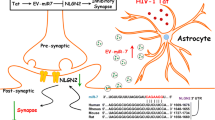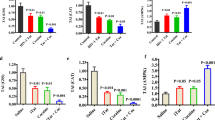Abstract
Diminished adult neurogenesis is known to play a key role in the pathogenesis of diverse neurodegenerative disorders such as HIV-associated neurological disorders (HAND). Cocaine, often abused by HIV-infected patients, has been suggested to worsen HIV-associated CNS disease. Mounting evidence also indicates that HIV infection can lead not only to neuronal dysfunction or loss, but can also negatively impact neurogenesis, resulting in generation of fewer adult neural progenitor cells (NPCs) in the dentate gyrus of the hippocampus, brain area critical for memory and learning. The crucial role of platelet-derived growth factor-BB (PDGF-BB) in providing tropic support for the neurons as well as in promoting NPC proliferation has been demonstrated by us previously. However, whether PDGF-BB regulates neuronal differentiation especially in the context of HAND and drug abuse remains poorly understood. In this study, we demonstrate that pretreatment of rat hippocampal NPCs with PDGF-BB restored neuronal differentiation that had been impaired by HIV Tat and cocaine. To further study the intracellular mechanism(s) involved in this process, we examined the role of transient receptor potential canonical (TRPC) channels in mediating neuronal differentiation in the presence of PDGF-BB. TRPC channels are Ca2+-permeable, nonselective cationic channels that elicit a variety of physiological functions. Parallel but distinct ERK, Akt signaling pathways with downstream activation of CREB were found to be critical for neuronal differentiation. Pharmacological blocking of TRPC channels resulted in suppression of PDGF-mediated differentiation and PDGF-BB-induced activation of ERK and Akt, culminating also to inhibition of PDGF-induced activation of CREB. Taken together, these findings underpin the role of TRPC channel as a novel target regulating cell differentiation mediated by PDGF-BB. This finding could have implications for development of therapeutic interventions aimed at restoration of Tat and cocaine-mediated impairment of neurogenesis in drug abusing HAND patients.






Similar content being viewed by others
References
Dhillon NK et al (2007) Cocaine-mediated enhancement of virus replication in macrophages: implications for human immunodeficiency virus-associated dementia. J Neurovirol 13(6):483–495
Yao H et al (2011) Cocaine hijacks sigma1 receptor to initiate induction of activated leukocyte cell adhesion molecule: implication for increased monocyte adhesion and migration in the CNS. J Neurosci 31(16):5942–5955
Yang L et al. (2015) Role of sigma receptor in cocaine-mediated induction of glial fibrillary acidic protein: implications for HAND. Mol Neurobiol
Yao H et al (2010) Molecular mechanisms involving sigma receptor-mediated induction of MCP-1: implication for increased monocyte transmigration. Blood 115(23):4951–4962
Venkatesan A et al (2007) Adult hippocampal neurogenesis: regulation by HIV and drugs of abuse. Cell Mol Life Sci 64(16):2120–2132
Bath KG, Lee FS (2010) Neurotrophic factor control of adult SVZ neurogenesis. Dev Neurobiol 70(5):339–349
Yao H et al (2012) Platelet-derived growth factor-BB restores human immunodeficiency virus Tat-cocaine-mediated impairment of neurogenesis: role of TRPC1 channels. J Neurosci 32(29):9835–9847
Smits A et al (1991) Neurotrophic activity of platelet-derived growth factor (PDGF): rat neuronal cells possess functional PDGF beta-type receptors and respond to PDGF. Proc Natl Acad Sci U S A 88(18):8159–8163
Pan YW et al (2012) Inhibition of adult neurogenesis by inducible and targeted deletion of ERK5 mitogen-activated protein kinase specifically in adult neurogenic regions impairs contextual fear extinction and remote fear memory. J Neurosci 32(19):6444–6455
Shioda N, Han F, Fukunaga K (2009) Role of Akt and ERK signaling in the neurogenesis following brain ischemia. Int Rev Neurobiol 85:375–387
Sakamoto K, Karelina K, Obrietan K (2011) CREB: a multifaceted regulator of neuronal plasticity and protection. J Neurochem 116(1):1–9
Pan Z, Yang H, Reinach PS (2011) Transient receptor potential (TRP) gene superfamily encoding cation channels. Hum Genomics 5(2):108–116
Boudes M et al (2013) Crucial role of TRPC1 and TRPC4 in cystitis-induced neuronal sprouting and bladder overactivity. PLoS One 8(7), e69550
Zhu X et al (2009) PDGF-mediated protection of SH-SY5Y cells against Tat toxin involves regulation of extracellular glutamate and intracellular calcium. Toxicol Appl Pharmacol 240(2):286–291
Yang L et al (2013) Involvement of miR-9/MCPIP1 axis in PDGF-BB-mediated neurogenesis in neuronal progenitor cells. Cell Death Dis 4, e960
Chao J et al (2014) Platelet-derived growth factor-BB restores HIV Tat-mediated impairment of neurogenesis: role of GSK-3beta/beta-catenin. J Neuroimmune Pharmacol 9(2):259–268
Park D et al (2010) Nestin is required for the proper self-renewal of neural stem cells. Stem Cells 28(12):2162–2171
Ming GL, Song H (2011) Adult neurogenesis in the mammalian brain: significant answers and significant questions. Neuron 70(4):687–702
Oliveira SL et al (2013) Functions of neurotrophins and growth factors in neurogenesis and brain repair. Cytometry A 83(1):76–89
Krathwohl MD, Kaiser JL (2004) HIV-1 promotes quiescence in human neural progenitor cells. J Infect Dis 190(2):216–226
Funa K, Sasahara M (2014) The roles of PDGF in development and during neurogenesis in the normal and diseased nervous system. J Neuroimmune Pharmacol 9(2):168–181
Mohapel P et al (2005) Platelet-derived growth factor (PDGF-BB) and brain-derived neurotrophic factor (BDNF) induce striatal neurogenesis in adult rats with 6-hydroxydopamine lesions. Neuroscience 132(3):767–776
Font MA, Arboix A, Krupinski J (2010) Angiogenesis, neurogenesis and neuroplasticity in ischemic stroke. Curr Cardiol Rev 6(3):238–244
Selvaraj S et al (2012) Neurotoxin-induced ER stress in mouse dopaminergic neurons involves downregulation of TRPC1 and inhibition of AKT/mTOR signaling. J Clin Invest 122(4):1354–1367
Fortin DA et al (2012) Brain-derived neurotrophic factor activation of CaM-kinase kinase via transient receptor potential canonical channels induces the translation and synaptic incorporation of GluA1-containing calcium-permeable AMPA receptors. J Neurosci 32(24):8127–8137
Boney CM, Smith RM, Gruppuso PA (1998) Modulation of insulin-like growth factor I mitogenic signaling in 3T3-L1 preadipocyte differentiation. Endocrinology 139(4):1638–1644
Reffas S, Schlegel W (2000) Compartment-specific regulation of extracellular signal-regulated kinase (ERK) and c-Jun N-terminal kinase (JNK) mitogen-activated protein kinases (MAPKs) by ERK-dependent and non-ERK-dependent inductions of MAPK phosphatase (MKP)-3 and MKP-1 in differentiating P19 cells. Biochem J 352(Pt 3):701–708
Agell N et al (2002) Modulation of the Ras/Raf/MEK/ERK pathway by Ca(2+), and calmodulin. Cell Signal 14(8):649–654
Fukuchi M, Tabuchi A, Tsuda M (2005) Transcriptional regulation of neuronal genes and its effect on neural functions: cumulative mRNA expression of PACAP and BDNF genes controlled by calcium and cAMP signals in neurons. J Pharmacol Sci 98(3):212–218
Kim SY et al (2002) Activation of p38 MAP kinase in the rat dorsal root ganglia and spinal cord following peripheral inflammation and nerve injury. Neuroreport 13(18):2483–2486
Sodhi A, Biswas SK (2002) Monocyte chemoattractant protein-1-induced activation of p42/44 MAPK and c-Jun in murine peritoneal macrophages: a potential pathway for macrophage activation. J Interferon Cytokine Res 22(5):517–526
Lonze BE, Ginty DD (2002) Function and regulation of CREB family transcription factors in the nervous system. Neuron 35(4):605–623
Kingsley-Kallesen ML, Kelly D, Rizzino A (1999) Transcriptional regulation of the transforming growth factor-beta2 promoter by cAMP-responsive element-binding protein (CREB) and activating transcription factor-1 (ATF-1) is modulated by protein kinases and the coactivators p300 and CREB-binding protein. J Biol Chem 274(48):34020–34028
Acknowledgments
This work was supported by grants DA036157 and DA033150 from the National Institutes of Health.
Authorship
Contribution: L.Y. designed and performed research and wrote the manuscript; X.C. performed research; G.H.designed all primers and performed research; Y.C. and K.L performed research and S.B. planned and designed the research and wrote the manuscript.
Author information
Authors and Affiliations
Corresponding author
Ethics declarations
Conflict of Interest
The authors declare that they have no competing interests.
Additional information
Lu Yang and Xufeng Chen contributed equally to this work.
Rights and permissions
About this article
Cite this article
Yang, L., Chen, X., Hu, G. et al. Mechanisms of Platelet-Derived Growth Factor-BB in Restoring HIV Tat-Cocaine-Mediated Impairment of Neuronal Differentiation. Mol Neurobiol 53, 6377–6387 (2016). https://doi.org/10.1007/s12035-015-9536-0
Received:
Accepted:
Published:
Issue Date:
DOI: https://doi.org/10.1007/s12035-015-9536-0




